Thanks to its rich, buttery flavor, salmon is the favorite fish of many healthy eaters. But when it comes to cooking this cold-water delicacy, it’s easy to get stuck in a rut.
There is nothing inherently wrong with baked fillets, but why not experiment a little? Salmon burgers, smoked-salmon omelets, salmon cakes over greens, salmon steaks grilled on a cedar plank — the possibilities are endless.
Like veggies and fruits, fresh wild salmon is seasonal, with different varieties available from spring to autumn. Frozen salmon (both wild and farmed) is available year-round, but farmed salmon is generally much less nutritious and flavorful. It’s also less environmentally sustainable and may contain a greater concentration of toxins. So choose wild salmon whenever you can.
Here are our tips for identifying good, sustainable salmon and how to prepare it in both simple and imaginative ways.
Nutritional Know-How
- Wild salmon is an excellent source of omega-3 fatty acids, such as EPA and DHA. Omega-3s are critical for heart, joint, eye, and brain health.
- Recent studies indicate that salmon’s bioactive peptides — which are small protein molecules — may help control inflammation in our digestive tracts and support insulin effectiveness and healthy joints.
- Salmon is an excellent source of the mineral selenium, which provides cardiovascular protection, decreases the risk of joint inflammation, and might help prevent certain types of cancer.
- Unlike most large predator fish — tuna, swordfish, and shark, for example — salmon contains little mercury.
Shopping and Storage Tips
- Buy fresh wild salmon when it’s in season, from spring to autumn. The healthiest wild salmon for both you and the environment currently comes from Alaska.
- If you can’t find fresh wild salmon, try arctic char or fresh trout, which are related to salmon. Canned wild salmon is the next best choice.
- Avoid most farm-raised salmon, which may have elevated levels of polychlorinated biphenyls (PCBs), are often treated with antibiotics, and can fill surrounding waters with waste and pollution.
- Look for salmon flesh that is bright, shiny, and firm. White marbling indicates the all-important omega-3 fatty acids.
- Choose belly fillets, as opposed to tails, as they contain the most healthy fats.
- If you purchase salmon the day after it was caught, it will keep for up to four days in the refrigerator.
Kitchen Tricks
- The secret to perfectly moist salmon is to slightly undercook the fish and then let it rest for a few minutes as it cooks the rest of the way through.
- When broiling, you’ll know salmon is done when the top is just brown, some whiteness appears from the fat, and there is some — but not too much — resistance when you press down on it. Check fish by cutting into the thickest part. At the bottom, the fish should be translucent, slightly raw-looking, and easily parted with a table knife.
- Though it has a distinctly strong taste, salmon skin contains peptides that are important for our health. Try eating skin from wild Alaskan salmon. For other salmon, remove skin after cooking to reduce exposure to persistent organic pollutants.
Cajun Salmon Burger
Salmon burgers can be prepped a day in advance. To save time, ask your butcher to skin and bone the fish. In a pinch, you can also use canned or leftover salmon. For an Italian-inspired burger, substitute fresh basil for the green onions and sun-dried tomatoes or olives for the jalapeños. For a burger with an Asian flair, add a teaspoon of fresh grated gingerroot, and use tamari and cayenne instead of salt and pepper.

Makes six burgers | Preparation time 30 to 45 minutes
Ingredients
- 1 1/2 pounds salmon fillets, skin and bones removed, cut into approximately 1-inch cubes (or substitute 16 oz. canned salmon)
- 1 jalapeño pepper, minced
- 1/4 cup minced green onion
- 1/2 cup quinoa flakes
- 1 tsp. smoked Spanish paprika
- Salt and freshly ground black pepper
- Extra-virgin olive oil for cooking
- 6 whole-grain or gluten-free buns, buttered and toasted
- 3 cups baby kale or spinach
- 6 tomato slices
- 1/2 red onion, thinly sliced
- 2 tbs. mayonnaise
- 2 tbs. Dijon mustard
- 1 tsp. chopped fresh tarragon or Italian parsley
Directions
- Place a quarter of the salmon in a food processor and blend into a paste. Pulse in the remaining fish, jalapeños, green onions, quinoa flakes, paprika, salt, and pepper until the fish is cut into 1/4-inch pieces.
- Shape the mixture into six patties.
- Heat the oil in a heavy skillet over medium heat. Cook the patties for three to four minutes on each side until heated through.
- Top each bun bottom with greens, a tomato slice, some onions, and a salmon patty. Mix the mayonnaise, mustard, and herbs together and serve as shown.
Salmon and Veggies Baked in Parchment
Use any fresh veggies you have on hand for this recipe. The moisture and flavor from the vegetables help steam and season the salmon. The bags can be prepared a few hours before cooking and stored in the refrigerator.

Makes four servings | Preparation time 40 to 55 minutes
Ingredients
- 4 cups thinly sliced vegetables (carrots, zucchini, fennel, celery, leeks, asparagus, scallions, snow pea pods, tomatoes, kale, collard greens, etc.)
- 4 6-ounce salmon fillets
- 1/4 cup chopped fresh herbs (e.g., chives, fennel, dill, tarragon,
- parsley, oregano)
- Zest and juice of 1 lemon
- Salt and freshly ground black pepper
- 4 tsp. white wine (optional)
Supplies
- 4 unbleached parchment-paper sandwich bags
Directions
- Preheat oven to 400 degrees F.
- In each parchment bag, arrange 1 cup of mixed veggies. Top with a salmon fillet, and sprinkle with herbs, lemon zest and juice, salt, and pepper. Drizzle with white wine, if desired.
- Fold the edge of the parchment bag over two or three times and crimp to seal. Place the bags on a baking sheet on the middle rack of the oven and bake for 20 minutes.
- Remove the baking sheet from the oven and allow to sit for five minutes.
- Cut each bag open and serve.
Asian-Inspired Salmon Nicoise
A great showcase for fresh seasonal vegetables (you can sub in any you like or happen to have on hand), this recipe is a new take on the classic French salade niçoise. Cook and chill salmon in advance, or use leftover salmon if you prefer.
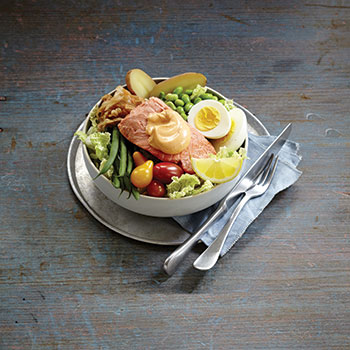
Makes four servings | Preparation time 45 minutes, plus time to chill the salmon, approximately three hours
Ingredients
- 8 cups shredded Napa cabbage
- 4 hard-cooked eggs, peeled and halved
- 2 cups cooked haricot vert (or green beans), about 6 ounces, blanched and chilled
- 6 ounces baby heirloom or red potatoes, cooked, cooled, and halved
- 1/2 cup kimchi
- 1 cup shelled edamame
- 12 cherry tomatoes
- 1 pound cooked salmon, chilled and separated into large pieces
- 1/2 cup mayonnaise
- 1 tbs. sriracha
- 4 lemon wedges
Directions
- Divide the Napa cabbage into four bowls. Arrange the eggs, beans, potatoes, kimchi, edamame, tomatoes, and salmon over the greens.
- Stir the mayonnaise and sriracha together, and add a dollop onto each salad. Garnish with a lemon wedge.
Miso Broiled Salmon
Miso is a fermented paste traditionally made with soybeans. There are many different types available; red miso is particularly good for this dish. Serve on a bed of brown rice with a side of braised greens.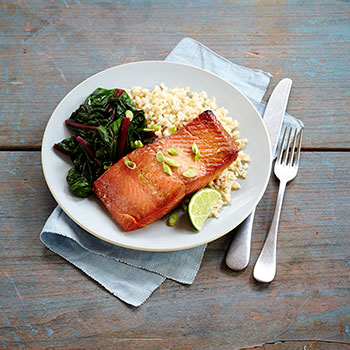
Makes four servings | Total preparation time Three to 24 hours marinating time and 25 minutes prep and cook time
Ingredients
- 1/4 cup red miso
- 1/4 cup mirin
- 1 tbs. grated fresh gingerroot
- 2 tbs. maple syrup
- 4 6-ounce salmon fillets
- 1 tsp. sesame oil
Directions
- Mix the miso, mirin, ginger, and maple syrup in a small bowl.
- Spread the miso mixture on both sides of the salmon fillets, and marinate in a covered dish in the refrigerator for at least three hours (and up to 24 hours).
- When ready to cook, make sure the top oven rack is 4 to 6 inches away from the top of the oven, and preheat the broiler. Place the salmon on a baking sheet lightly oiled with sesame oil and broil for four to six minutes, or until the salmon is cooked through.
WEBEXTRA
Which Fish?
Why the salmon you select matters
Many of us eat seasonal, locally grown vegetables and fruits that benefit both our health and the environment. And a growing number of us are seeking out free-range, organic chicken and pasture-raised beef. We’ve been slow, however, to make our way back to another tradition of our ancestors: eating seasonal, sustainable fish.
“Most of us still think our favorite fish should be available anytime we want them,” says Sheila Bowman, manager of culinary and strategic initiatives at the Monterey Bay Aquarium Seafood Watch. But that convenience doesn’t take natural cycles into account, she explains.
Seafood Watch offers science-based recommendations to help consumers, chefs, and businesses choose seafood that has been caught or farmed in ways that protect the ocean.
Salmon is a migratory fish, and it’s sustainably harvested from spring through fall only. So why is it available year round in our markets? Because, Bowman says, more than 66 percent of the salmon in our stores is farmed in open-net pens in the ocean, the equivalent of conventional cattle feedlots. Less than 1 percent, she adds, is farmed sustainably in concrete structures on land.
Since salmon do not live long, they don’t have mercury problems like tuna and swordfish. And thus far, the U.S. Food and Drug Administration, which monitors fish for radioactivity, states that it “has no evidence that radionuclides from the Fukushima incident are present in the U.S. food supply at levels that would pose a public health concern.”
But salmon do contain toxins if they’ve had prolonged exposure to runoff from land containing PCBs or been bathed in chemicals — a regular occurrence at fish farms where diseases and parasites can be a problem.
Fish food at farms is another concern. “Salmon are carnivorous. To feed them, hundreds of thousands of tons of small fish like herring and sardines — species that support the ocean food web, including feeding whales, seals, and tuna — are turned into pellets,” says Bowman. “It takes 3 or more pounds of small wild fish to make 1 pound of salmon.” And that just doesn’t make good sense, says Bowman. Viewed globally, she says, we’re talking about a “net loss of protein — not a good idea on a planet with 8 billion people.”
Ocean ecosystems can also suffer when species are moved about in farms. Most salmon are farmed in open pens and cages in coastal waters. Waste from these farms is released directly into the ocean. Parasites and diseases from farmed salmon can spread to wild fish swimming near the farms, and escaping farmed salmon can harm wild populations. As a result, most salmon farmed in ocean-net pens get an “Avoid” rating from Seafood Watch.
When looking at wild fisheries, Seafood Watch considers the impacts on the habitat, how many other untargeted fish are being caught in the process, and whether enough fish are left in the water to keep populations healthy.
At this time, wild salmon from Alaska is at the top of its list of best choices. “Alaska is handling their fisheries beautifully,” says Bowman. “It’s where the best wild salmon is coming from now.”
When you’re buying salmon, she recommends, ask your fish market for wild Alaskan salmon when it’s in season — from spring to autumn. “If you want to eat salmon in the winter, it should be frozen or canned,” says Bowman.
Wild salmon usually costs more than farmed fish, but she recommends we “keep eating sustainable fish, knowing that the extra expense supports businesses that are protecting the oceans.”
If you can’t find wild salmon, the healthiest, most sustainable choice is to diversify your diet. “Arctic char and rainbow trout are great alternatives to salmon,” says Bowman. “They’re a much better environmental choice than farmed salmon, and they’re also rich in omega-3s.”
You can learn more about ocean-friendly seafood choices at the Seafood Watch website, www.seafoodwatch.org. They also offer a mobile app that includes Project FishMap, which lets you share locations of restaurants and markets with sustainable seafood.
This article originally appeared as “Savoring Salmon” in the September 2014 issue of Experience Life.
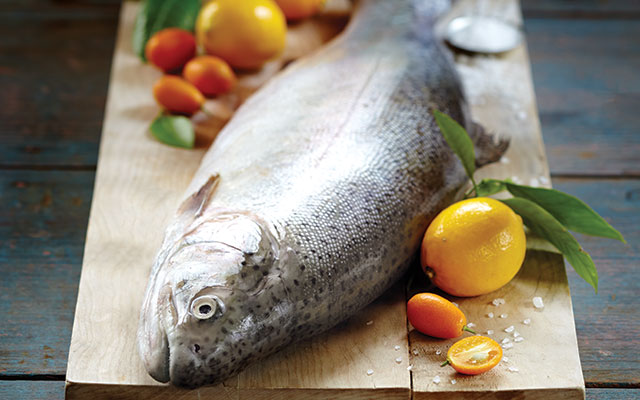
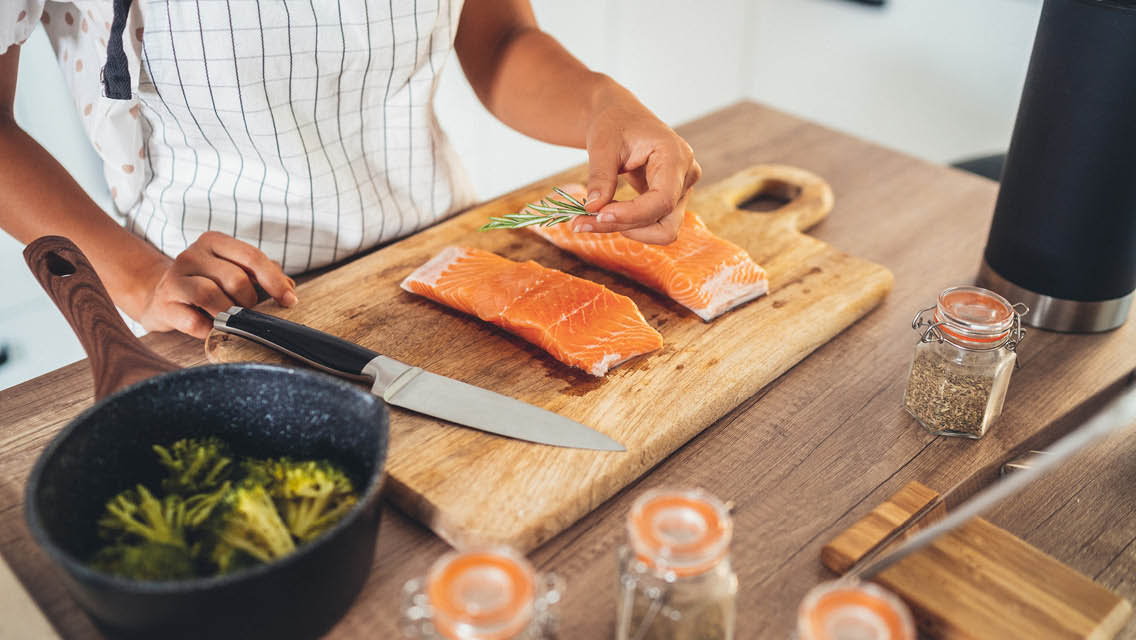
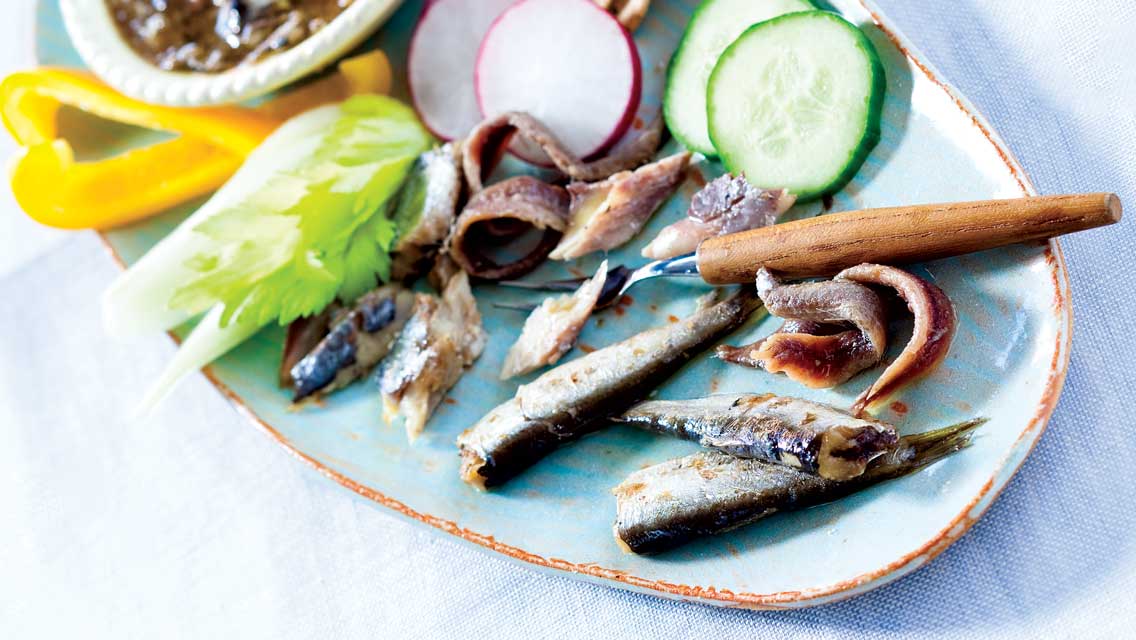

This Post Has 0 Comments